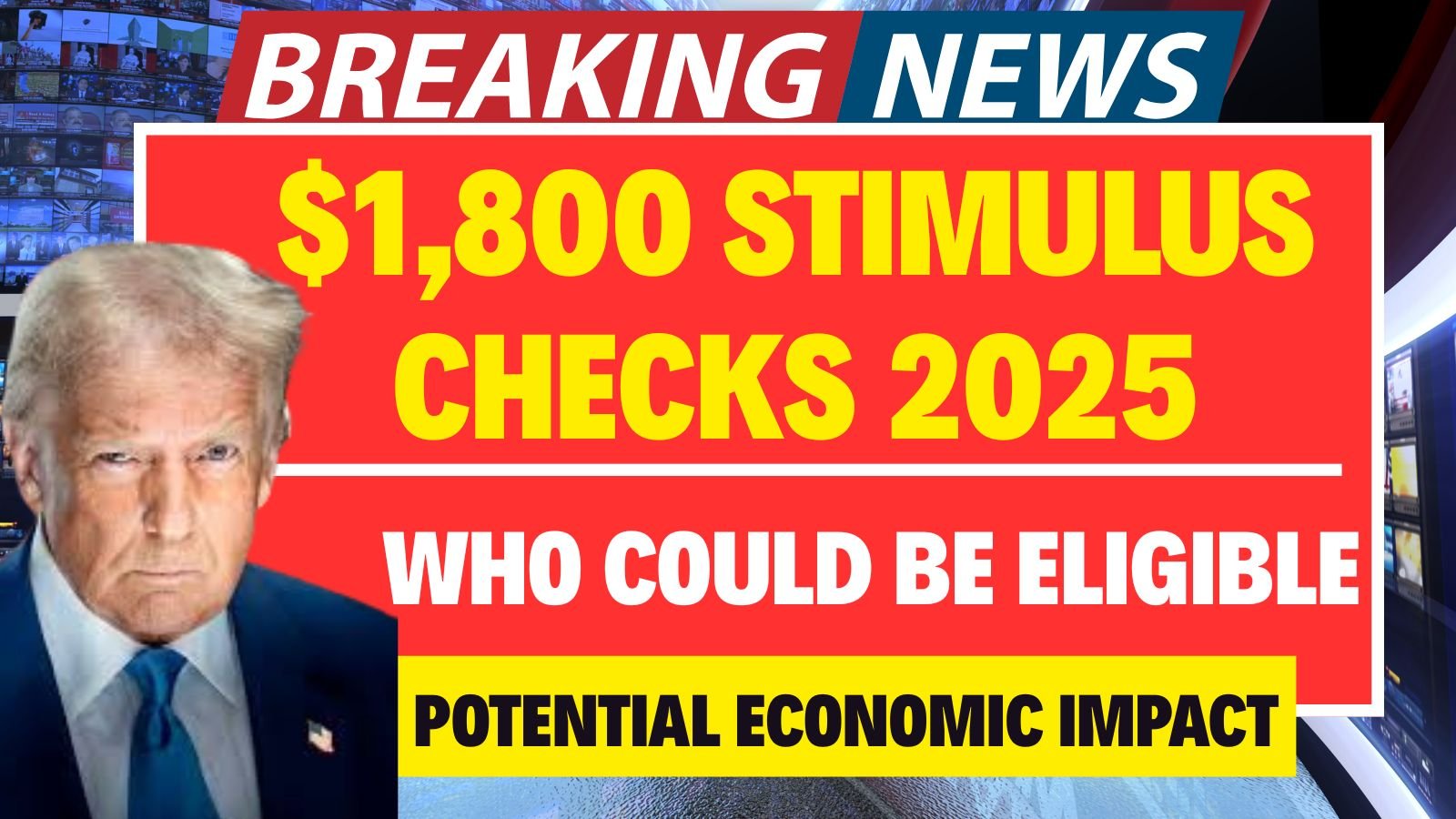As financial pressures continue to weigh heavily on American households, the conversation around the $1800 Stimulus Checks 2025 has ignited hope for millions of families across the country. Despite improvements in certain economic indicators like unemployment rates and GDP growth, a significant portion of the population is still grappling with the rising cost of living. From soaring housing prices and inflated grocery bills to persistent medical expenses and stagnant wages, many Americans find themselves walking a financial tightrope. The proposed $1800 stimulus checks for 2025 aim to ease this burden by offering direct cash relief to those who need it the most.
This plan has quickly gained national attention, as it addresses the continuing disparity between economic recovery on paper and the real-life struggles faced by everyday citizens. While the proposal has yet to be officially signed into law, understanding its purpose, structure, and potential impact can help Americans prepare for what may lie ahead.
Alaska’s $1,702 Stimulus Payment in 2025: Essential Financial Support in Tough Times
Understanding the Purpose Behind the $1800 Stimulus Checks 2025
The proposed $1800 stimulus checks 2025 are envisioned as a form of Economic Impact Payment (EIP), much like the relief packages rolled out during the peak of the COVID-19 pandemic. These payments are designed to serve a dual function. On one hand, they offer immediate financial assistance to individuals and families who are facing economic hardship. On the other hand, they stimulate broader economic activity by increasing consumer spending, which in turn supports local businesses and contributes to national recovery.
In 2025, although some industries have rebounded, others remain in a fragile state. Inflation continues to be a major concern. Many households have exhausted their savings and are relying on credit to meet their daily needs. For people living paycheck to paycheck, especially seniors on fixed incomes, single-parent households, veterans, and small business owners, this stimulus payment could serve as a financial lifeline.
The $1800 figure isn’t arbitrary—it’s based on current economic analysis that considers inflationary pressures, cost of living adjustments, and the average financial shortfall that American families are experiencing each month. If approved, the $1800 stimulus checks 2025 could provide essential breathing room for millions of struggling citizens.
Who Would Qualify? Income Limits and Eligibility Details
If Congress greenlights the proposal, the eligibility criteria for the $1800 stimulus checks 2025 would most likely mirror those used in prior federal stimulus efforts. These checks are expected to be income-tested, ensuring that they reach the individuals and families most in need.
Here’s a breakdown of the expected qualifications:
-
Single Filers: Individuals with an Adjusted Gross Income (AGI) of up to $75,000 would be eligible for the full $1800 payment. For incomes between $75,000 and $99,000, the amount would gradually decrease based on a phase-out model.
-
Married Couples Filing Jointly: Couples earning a combined AGI of up to $150,000 would receive the full payment. Those with incomes between $150,000 and $198,000 would still qualify but for a reduced amount.
-
Head of Household Filers: Similar thresholds would apply, though the cutoff for reduced payments might be slightly higher due to the inclusion of dependents.
-
Families with Children: An added incentive in the form of additional funds per qualifying child under the age of 17 could also be included, as seen in previous rounds. This would significantly increase the total payment for larger households, helping to cover essential expenses such as childcare, food, and education.
Eligibility could also be extended to include Social Security recipients, veterans receiving disability benefits, and certain low-income individuals who do not typically file tax returns. That said, the IRS would likely rely on previously filed tax information to determine who qualifies, meaning it’s critical that all eligible individuals file their 2024 tax returns on time.
How the Funds Would Be Distributed
If the $1800 stimulus checks 2025 receive official approval, the IRS would oversee the distribution process using the same infrastructure developed during earlier pandemic relief programs. This efficient system ensures that funds can be disbursed quickly and accurately to those who qualify.
-
Direct Deposit: The most rapid method of delivery would be direct deposit. Individuals whose bank information is already on file with the IRS—typically from previous tax returns or past stimulus checks—would likely receive their payment within a few weeks of rollout.
-
Paper Checks: For recipients without current banking details, the IRS would issue paper checks via mail. These typically take longer to arrive and may be impacted by postal delays, so it’s advisable to ensure your address is up-to-date.
-
Prepaid Debit Cards: As was the case in previous stimulus rounds, some individuals may receive prepaid debit cards loaded with the appropriate amount. These are particularly useful for people without traditional banking access.
The entire distribution timeline will depend on how quickly the proposal passes through Congress. Once authorized, it’s estimated that the first wave of payments could begin within 3 to 4 weeks, with the full distribution taking a few months to complete.
Tracking Your Payment and Updating Information
One of the more helpful tools from previous stimulus rounds was the IRS “Get My Payment” portal, which allowed users to track the status of their payment and update critical information. It’s expected that a similar system would be used for the $1800 stimulus checks 2025.
To avoid any issues or delays:
-
Make sure your tax returns are up-to-date, particularly for the 2024 filing year.
-
If you’ve recently changed your bank account or moved to a new residence, update your information with the IRS promptly.
-
Be alert to official government communications. Any announcements or updates will likely come through the IRS, Treasury Department, or your congressional representative.
-
Be cautious of scams. Fraudulent actors often capitalize on periods of financial uncertainty. The IRS will never ask for personal information via email, text message, or social media.
Where Things Stand: Is the Proposal Likely to Pass?
At this stage, the $1800 stimulus checks 2025 are still in the proposal phase and must go through the formal legislative process before becoming reality. The bill would need to be introduced in either the House or the Senate, debated, possibly amended, and then passed by both chambers before heading to the President for approval.
Support for additional stimulus payments is growing, especially among lawmakers who represent economically vulnerable districts. There is increasing bipartisan recognition that while Wall Street may be booming, Main Street is still struggling. Several legislators have voiced their backing for new relief measures to address the growing wealth gap and ensure that all Americans benefit from the nation’s economic progress.
However, the path forward is not without obstacles. Political divisions, concerns over the federal budget deficit, and debates about government spending could slow down or even derail the proposal. Advocates argue that the long-term benefits of supporting consumer spending and stabilizing households far outweigh the short-term costs.
How to Prepare While You Wait
While the legislative wheels turn, there are several proactive steps that individuals and families can take to ensure they’re ready if the $1800 stimulus checks 2025 are approved:
-
File Your Taxes: If you haven’t already submitted your 2024 tax return, make that a priority. Your AGI from this return will be a key determinant of your eligibility and the amount you receive.
-
Check Your IRS Information: Log into your IRS account or use the IRS website to confirm your direct deposit info, mailing address, and filing status.
-
Create a Financial Plan: Think ahead about how you’d use the money. Would you pay off high-interest debt? Build up an emergency fund? Catch up on utility bills? Having a plan will help ensure that the funds make a meaningful difference.
-
Beware of Scams: Scammers often prey on hope and confusion during these times. Stay informed through legitimate channels and never share personal financial information unless you’re on a verified government website.
Final Thoughts on the $1800 Stimulus Checks 2025
The proposed $1800 stimulus checks 2025 represent a renewed effort to address the ongoing economic challenges that many Americans still face. Whether you’re a single parent trying to put food on the table, a retiree managing on a fixed income, or a worker whose wages haven’t kept pace with inflation, this relief payment could offer some much-needed stability.
Although not yet finalized, the structure of the proposal suggests a well-organized plan that builds on the successes—and lessons—of previous stimulus programs. With public interest surging and congressional discussions gaining momentum, there’s cautious optimism that the plan will move forward in the coming months.
Americans should continue monitoring reliable government sources for updates while taking practical steps now to ensure they’re eligible and ready to receive the payment, should it be approved. In an economy marked by uncertainty and uneven recovery, the $1800 stimulus checks 2025 could be a vital financial cushion for millions navigating life’s daily challenges.
Disclaimer: The information provided in this article is based on current public proposals and discussions regarding the $1800 stimulus checks 2025. It is intended for informational purposes only and does not constitute financial advice. Final details regarding the amount, eligibility, and distribution methods may change based on legislative developments. Please refer to official IRS or government sources for the most accurate and updated information.
Some Important Link
| Download News APP | Click Here |
| WhatsApp Group | Click Here |
| Home Page | Click Here |




